by GM Igor Smirnov
Remote Chess Academy
http://chess-teacher.com
Today we have a very interesting topic: the secrets of strong players.
During a game of chess you demonstrate your way of thinking. Obviously there is a difference in the way of thinking between strong and not-so-strong players, but what is it about their way of thinking that makes these players stronger and helps them to gain more victories?
If you have pondered such questions before, you may have discovered that finding the answer is not that easy. Perhaps you have found that many of these strong players are unwilling to share these ‘insider secrets’ with you.
Similarly, there are a lot of lessons out there prepared by strong Grandmasters that will show you some opening moves or some strong moves played in the games of strong Grandmasters. However, they do not reveal the most important thing: How do these players find such strong moves and how can you do the same?
Today, however, you are in luck as this is exactly the topic of this lesson. Today we will be discussing powerful techniques for finding strong moves!
Naturally I cannot cover everything in just one lesson. Nevertheless, I will give you a couple of practical and powerful recommendations that you’ll be able to implement and improve your results with right after this lesson.
#1 TO TAKE IS A MISTAKE
In order to demonstrate the difference in the way of thinking between strong and not-so-strong players, let’s consider the following example:
Diagram 1
GM Reinderman – GM Nyzhnyk

White to move
In this position White played 29. Rxd6 (winning a pawn) and then Black played 29…Qe5. Perhaps Black wanted to block White’s e-pawn while at the same time attack White’s queen and also keep an eye on the d6-rook. But here I have a question for you. How would you play here as White?
I’m pretty sure that most players would just take Black’s queen on e5. Generally, when you have a material advantage it is good to exchange pieces. However, in this position it is not the best move because if White takes Black’s queen on e5, he will only have succeeded in helping Black to activate his knight and bring it to a good central square.
So what to do instead? If you have studied my previous lessons you will know already that to take is a mistake and that in such positions it is far better that you maintain the tension and let your opponent be the one who releases this tension.
Accordingly, White played 30. Kh2 and now you can see this idea clearly. If White takes Black’s queen on e5 Black will activate his knight and put it on a good central square. The opposite situation is applicable for Black. If Black takes White’s queen on g3, it will help White to activate his king and bring it closer to the center.
In the actual game, Black took White’s queen (30…Qxg3+) and after the recapture (31. Kxg3) White achieved an easily winning position. Notice that White can bring his king to f4 and then push e5, he has an extra pawn and Black has a lot of weaknesses. This is totally winning for White.
So now you know one secret of strong players: they understand the rule that to take is a mistake. It may sound rather simple but most players do not follow this rule or do not know about it. What they actually do is the opposite thing and they take whenever they can. Why do so many players make this mistake? It’s actually quite easy to explain. Consider for a moment the following example:
Diagram 2
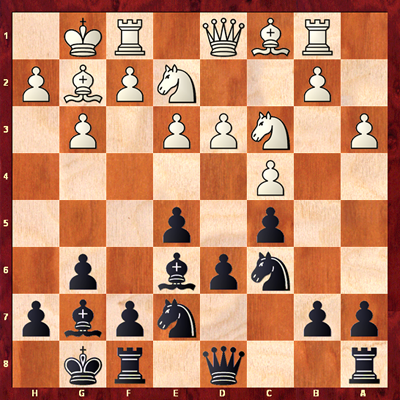
Black to move
Now, imagine that you are playing Black and you are considering the move 10…d5. Which variations do you need to check before you can play this move?
Obviously you need to be sure that you don’t lose any material and so maybe you start your calculation and think to yourself, “Okay, I’ll play d5 and after cxd5 I’ll take with my knight (Nxd5), he’ll recapture with his knight (Nxd5), I’ll take on d5 again with my bishop (Bxd5), he’ll take with his bishop (Bxd5), I’ll take with my queen (Qxd5).” And then you see that everything is fine and say to yourself, “Okay, I can play d5.”
This is the usual method of calculating variations and after some practice it becomes a habit. That’s why most chess players follow this way of thinking automatically. When they see that they can take something they start their calculations right from that move. Stronger players, on the other hand, know that to take is a mistake and that they should look for something better.
Before we move on, let me just clarify something. Of course I’m not saying that you should never take. Sometimes you can win an opponent’s material and sometimes you are forced to recapture in order to keep the material balance. In such cases of course you will naturally take. To give you an example, let’s go back a few moves in this game.
If after Black plays 10…d5 White responds with 11. cxd5, then of course Black must recapture. If he does not he will lose material and so there is nothing to think about. He has no other option but to take. However, in the subsequent position after 11…Nxd5 (see Diagram 3 below) White should not take on d5. This would be a mistake and White should refrain from making this move because of the rule: to take is a mistake.
Diagram 3
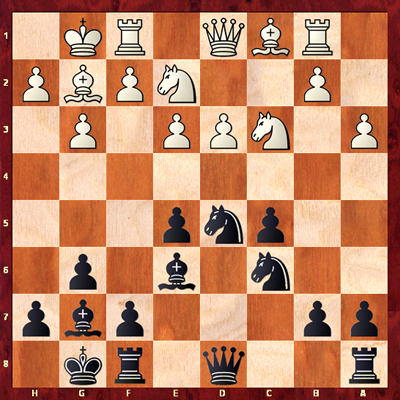
White to move
Now that you know the rule that to automatically take is a mistake, and that you should always try to maintain the tension, let’s move on a little.
#2 OFFENSE IS THE BEST DEFENSE
Okay. Let’s continue our exploration of the way strong players think with another example. Below is a theoretical position from the Sicilian defense, Najdorf variation.
Diagram 4
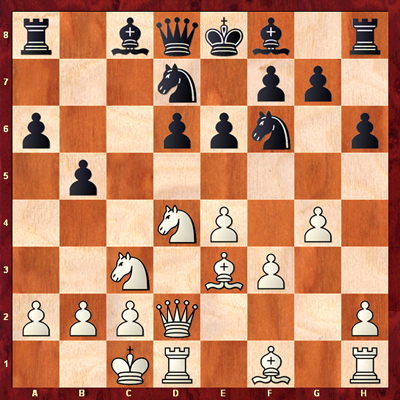
Black to move
Let’s say that Black plays 12…b4 attacking the knight, White retreats the knight to e2 (13. Nce2), Black plays 13…Qc7, White replies with 14. h4 (preparing an attack on the king-side) and Black answers with 14…d5 (attacking White’s centre and more specifically, the pawn on e4).
Diagram 5
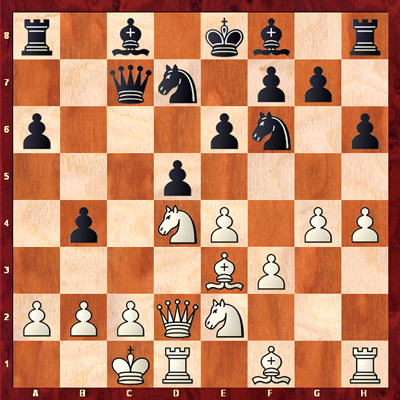
White to move
Okay? Now, here is a question for you. How would you play here as White?
I’ll be very glad if you decided not to take the d5 pawn. You know already that to take is a mistake and in this position it is indeed not the best option. After 15.exd5 Black will recapture with 16…Nxd5. With this move Black brings the knight into the centre, attacks White’s bishop on e3 and gains more activity. As a result White needs to find something better.
Although we know that we should try to keep the tension and avoid moves like exd5, here it is not so easy to find a suitable way to keep the tension and somehow protect the e4-pawn:
- White can’t play 15.Ng3 because that square is under control of Black’s queen on c7.
- A move like 15.Bg2 would place the bishop in a very passive position and after an exchange would cause the g4-pawn to be hanging. Also Black can move his knight to c4, so none of this looks very good for White.
- If White tries a move like 15.Qd3, a rather awkward idea, then Black can play 15…Ne5 or 15…Nc5 and gain extra tempi. Again, this is certainly not something that White would want.
Perhaps now you are thinking that if you don’t have a good way to defend the e4-pawn then maybe you just have to take on d5. This is certainly how most chess players think in such situations. However, this way of thinking has one major drawback: everything that we’ve been considering so far in this position has been focused on an opponent’s threats and we completely forgot about our own plans.
Let me give you a quick analogy. It is rather like a tug-of-war competition. Each side is trying to pull the rope in their own direction and the side who does it stronger will win the competition. A similar thing happens in chess. Each player is trying to pull the game in the direction that he wants, and the one who does it more insistently will win the game.
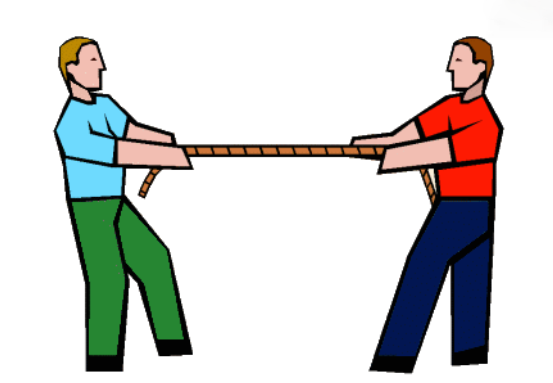
Having said that, let us take this new approach and apply it in the above position. Our task is to see what other resources we can find for White. We can do this by simply shifting our focus from Black’s threats to White’s plans.
Okay, so what is White’s plan here? Obviously White wants to push g5. That is why he played h4 and g4 on the previous moves. However, he cannot play g5 immediately because after 15…hxg, White cannot recapture with 16.hxg because the h-pawn is pinned to the undefended rook on h1. Therefore White needs to prepare this move somehow. He just needs to solve this problem of the hanging rook on h1.
We can find a couple of ideas for this purpose. For example:
- White could play 15.Bh3 and cover the h-file. Then after 15…dxe4 White can push g5 successfully. Also, the bishop on h3 attacks Blacks e6-pawn. Maybe White will sacrifice a piece there or he could push g6 and undermine this e6-pawn. All in all this position looks very promising for White. So that’s one interesting idea.
- At the very least White can remove the rook from danger by playing 15.Rg1 with similar ideas of pushing g5 and then g6 and developing an attack on the king-side. That’s another alternative.
In the actual game, White found another move with a similar idea. He played 15.Bf4 (attacking Black’s queen) and after Black played 15…e5 White played 16.Bh2. With this maneuver White has covered the h-file with his dark-squared bishop and he is ready to push g5. Of course Black cannot take the knight on d4 because the pawn is pinned and so he took on e4 (16…dxe4). After that, White pushed 17.g5 (see Diagram below).
Diagram 6
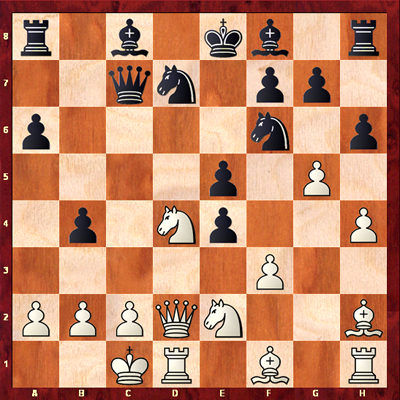
Black to move
As you can see, White is developing his attack. Of course it is still a very complicated position but White has good chances to develop a successful attack and Black should be really careful. For example, if after 17…hxg5, 18.hxg5 Black makes the natural move 18…Nd5 he is losing immediately as White can take with 19.Bxc5 (attacking Black’s queen and unleashing a discovered attack on Black’s h8-rook).
Okay, so let’s now go back to the critical position (Diagram 5). The important thing for you to take from this is that after we adopted a new approach, we were able to find a lot of interesting and powerful possibilities for White. This is a key difference between the way strong players and weak players think.
When attacked, weak players think of how to defend. Unlike them, strong players try to pull the game in the direction that they want and they always try to keep focusing on their own plans.
We can summarize these ideas by stating the rule: offense is the best defense. While I’m sure you’ve heard this several times in the past, without any real understanding of this idea the rule by itself is rather useless.
Let me be clear that I’m not talking about an active defense, or a counter-attack, or anything like that. I’m simply talking about another approach for the game. What I mean is that you should always try to push your own plan and try to lead the game in the direction that you want. It’s not about counter-blows or any kind of tactical tricks. It relates more to your deep understanding of the chess game and the adoption of the proper approach.
REVIEW
In this lesson we have been discussing the secrets of strong players. You now know two powerful secrets of these strong players. Let us review them quickly.
1. To take is mistake:
A major difference between strong and not-so-strong players is that when there is the possibility for an exchange, weaker players will usually just take automatically. Unlike them, strong players know that to take is a mistake and that you should therefore look for a way to keep the tension.
Strong players understand that it is often beneficial to let an opponent be the one to make the exchange and release the tension because it can help you to be more active. Additionally, they understand that such automatic exchanges can often just make your opponent’s choice of moves easier. In general you should provide your opponent with every opportunity to make a mistake.
Of course if you can win an opponents material, then you can and should take.
2. Offense is the best defense:
Another key difference between strong players and not-so-strong players is that when they are attacked, weaker players will usually think only about defense. Contrary to this, strong players follow the rule that offense is the best defense. They realize that it is a mistake to focus solely on your opponent’s threats and forget about your own plans.
Strong players understand that you should not make defensive moves automatically. Very often you will have something more powerful to play and you should look for it.
Strong players understand that chess is much like a tug-of-war competition where each player is trying to pull the game in the direction that he wants, and the one who does it more insistently will win the game.
I will end this here for now, but let me say in closing that when you know the secrets of strong players, everything becomes pretty simple. If you adopt these rules you may not become a Grandmaster overnight but your game will improve dramatically.
I wish you well-deserved success!
P.S. You may find lots of free video lessons and articles on the website of Remote Chess Academy: http://chess-teacher.com
Ein Gedanke zu „Secrets of Strong Players“
Kommentare sind geschlossen.